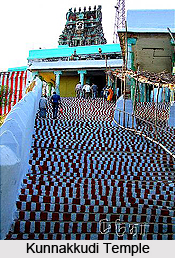 Kunnakkudi Temple is an ancient temple situated at Kunnakkudi in the Indian state of Tamil Nadu. This beautiful hill temple is dedicated to Lord Shiva or Shanmuganathar. The name Kunnakudi is derived from the sacred Kunru (hill) housing the temple. Kunnakkudi is also known as Mayuragiri, Arasavanam and Mayuranagaram.
Kunnakkudi Temple is an ancient temple situated at Kunnakkudi in the Indian state of Tamil Nadu. This beautiful hill temple is dedicated to Lord Shiva or Shanmuganathar. The name Kunnakudi is derived from the sacred Kunru (hill) housing the temple. Kunnakkudi is also known as Mayuragiri, Arasavanam and Mayuranagaram.
Legend of Kunnakkudi Temple
Legend has it that Lord Vishnu and Lord Brahma once visited Skanda whose peacock behaved with arrogance towards the guests. Skanda cursed the peacock - to turn into stone. The peacock manifested itself as a hill and performed his penance towards Skanda, after which he was restored to his original form. Part of the remaining rock is known as Mayuragiri or Kunnakkudi, and enshrines Skanda.
Architecture of Kunnakkudi Temple
The Togaiyadi Vinayakar shrine is located at the foot of the hill. Steps lead to the top of the hill. En route there is a shrine dedicated to Idumban - the hill temple. The Kunnakkudi temple was built by Marudu brothers. The sanctum faces the east. To the south of the sanctum is the impressive Alankara mandapam enshrining the utsav murthi of Shanmugar. There are also shrines dedicated to Vinayakar, Kuzhandai Vadivelar, Meenakshi Sundareswarar, Dakshinamurthy, Natarajar, Chandeswarar and the Navagrahams. Images of Veerabahu and Idumban are also seen at this temple. Most of the parts of the temple are cut from rock.
There is a cave temple dedicated to Shiva, which has a five-tiered gopuram at the foot of the hill. This temple is of great archeological significance. There are three caves here, dating back to the 8th century BC. The first enshrines a Shivalingam. One of the walls bears a sculpture of Vishnu, while the other bears an image of Lingapurnadeva, being worshipped by Brahma (with a miniature swan above him) and a four-armed Vishnu bearing a conch and discus. Also carved here are images of Durga and Harihara. There is a brilliant sculpture of Nataraja in this cave temple along with the image of Vinayaka and Subramanya.
Festivals of Kunnakkudi Temple
The annual festivals celebrated here are Thaipoosam and Panguniuttiram. Many devotees circumambulate the hill during these occasions. Mondays, in the month of Karthigai, are considered sacred here.





















